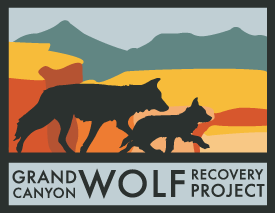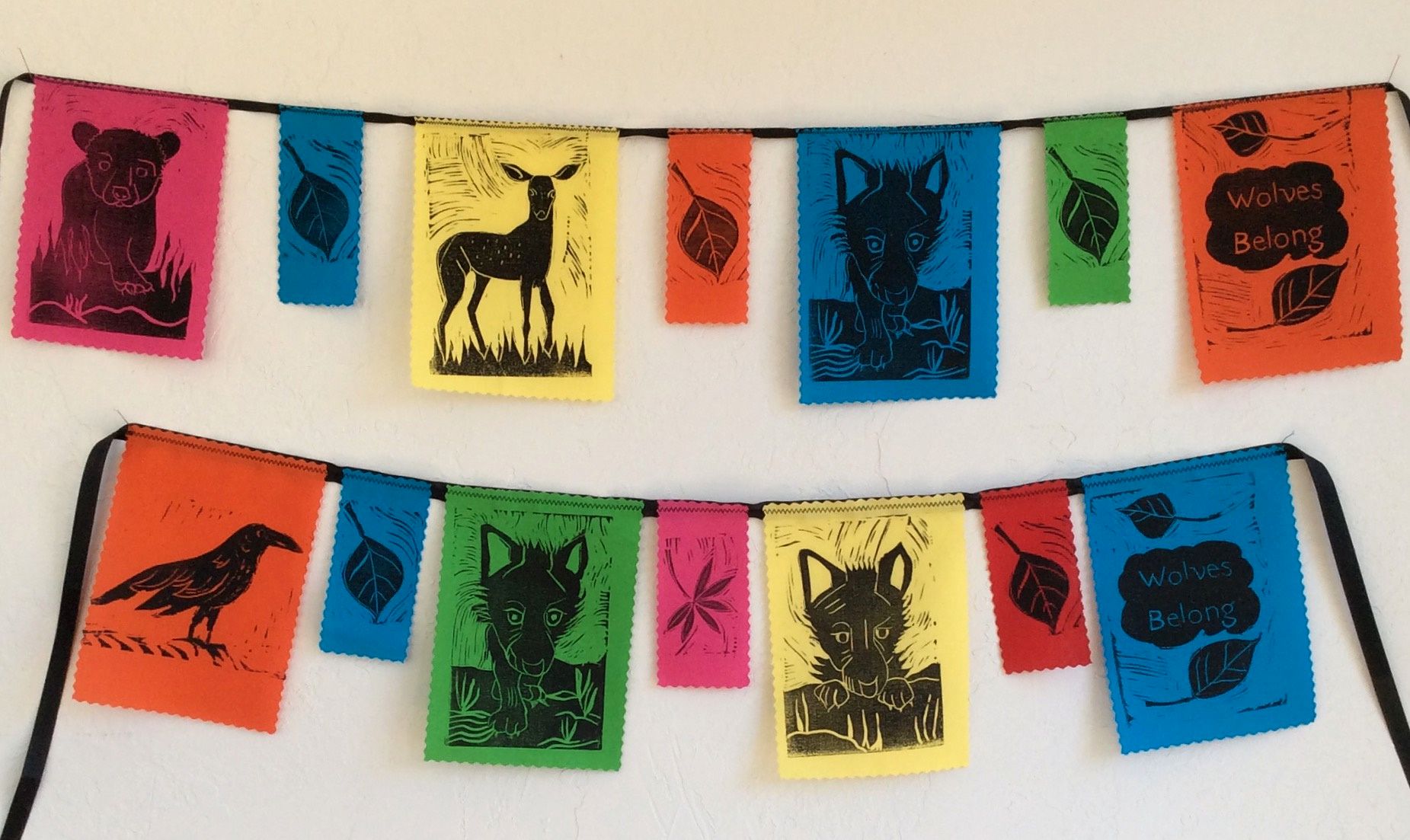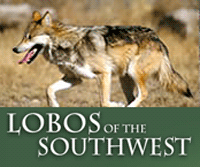Arizona Daily Sun (Original) Posted August 29, 2021 by Sam McManis
He was a lone wolf. He roamed and rambled. He lit out west and north, away from the pack, going his own way. His pursuers, bipeds with a helicopter and fancy tracking equipment, followed. But he eluded them until, inevitably, they closed in.
Is there anything more romantic, more iconic, more quintessentially American than that scenario? Jack London himself couldn’t have written this any better.
And the plight of this lone Mexican gray wolf that strayed from his federally designated habitat — nicknamed Anubis by school kids and called m2520 by officials — captured the imagination of animal activists and a segment of the public this spring and summer until the wolf was captured recently and sent back to the pack in the White Mountains.
You could see this as a defeat for Emily Renn and her Flagstaff-based nonprofit, the Grand Canyon Wolf Recovery Project, which is striving to promote the introduction of the endangered species to northern Arizona, beyond its federally mandated habitat area.
Then again, maybe not. Maybe the notoriety garnered by Anubis/m2520’s three-month odyssey in the Coconino National Forest raised awareness of the plight of the Mexican gray wolves, whose numbers ebbed to seven in the late 1970s but now total 186, collared and placed in packs such as Anubis’ Dark Canyon pack in New Mexico’s Gila National Forest.
Renn, the nonprofit’s executive director, along with board president Jeanne Trupiano, lament that wolves such as this are not allowed to wander -- as they say wolves are wont to do -- to expand the habitat, form new packs and boost its population and dwindling gene pool.
And yet, the two consider the episode as, on the whole, positive, a view not shared by Arizona Game and Fish Department and the U.S. Fish and Wildlife Service, the overseers of the Mexican gray wolf population recovery efforts.
“By Anubis getting captured,” Trupiano said, “it was kind of like he put himself out there for all (Mexican) gray wolves. Like saying, ‘Hey, we’re on the move.’ This puts pressure on the agencies involved to address this. The wolves are saying, ‘We aren’t going away or being contained.’ So it’s a good thing.
“We can’t just have a vestigial population in the White Mountains and think, great, we’ve preserved them. They have to be able to wander and form new packs.”
Or, as Renn ardently states, “I hope people are inspired by the potential to correct this wrong. I know of at least 10 wolves in this area going back 10 years. As the population grows, this will become more and more frequent. The real issue now is to influence a change in the management rules. Just the amount of money and resources used, and the stress on that animal, to have to move it back to a place he chose to move away from makes no sense.”
It makes perfect sense to federal and state officials, however. They are charged with reintroducing the Mexican gray wolf to what has been deemed its “historical habitat,” which in Arizona is the southeastern part of the state not exceeding Interstate 40 to the north.
Two views of what's best for wolves
While both environmentalists and conservationists and agencies such as Arizona Game and Fish say they want what is best for the wolves, their approaches in advocating for the endangered species could not be more different. To call their relationship contentious might be a howling understatement.
On one side is Jim deVos, Mexican gray wolf coordinator for AZGF, who maintains the stray wolf was captured and returned for its own safety, because it had crossed traffic-heavy I-40 and Highway 180 on several occasions and was spotted close to homes in the Baderville area, northwest of Flagstaff. He said he feared that the wolf, which he calls 2520, would be mistaken for a coyote by homeowners and shot.
“It’s easy to sit back and criticize the department’s decision,” deVos said. “But I’m here to make a reasonable decision on how we handle the Mexican wolf for what’s in the best interest of the wolf. We’ve had four wolves killed (since program started) on thoroughfares around Flagstaff and northern Arizona.
“Whether you want to use the term ‘habituate’ or not, the fact was that 2520 was spotted really close to (homes) in Baderville. And the primary mortality for wolves is illegal shooting, or accidental shooting. It’s important to note that this particular wolf, while it tugged at a lot of emotions in people, it’s one out of 186. Let’s focus on the success of the other ones. No matter what we do, someone’s going to be critical of the decisions I and others make in this thing called conservation.”
Renn asserts that those with Game and Fish do not want wolves in northern Arizona, in part, because the area boasts prime hunting land for elk, which wolves prey upon. Renn said most northern Arizona ranchers have no problem with wolves bothering their livestock. Still, as a Center for Biological Diversity official alleged in a 2020 Cronkite News story about the killing of four wolves said to be preying upon livestock in New Mexico, governmental agencies have subsumed real efforts to expand wolf habitat because “it’s in the pockets of the livestock industry.”
The Arizona Cattle Growers Association calls wolf predation a threat to members’ livelihoods. Darcy Ely, a spokesperson for the cattle growers, wrote in an email response: “The Mexican wolf does harass and kill the livestock. The Mexican wolf has attacked the working dogs and horses while working the cattle, which is a huge safety issue.”
Responding to Renn’s assertion that state and federal wildlife officials limit wolf habitat to placate hunters and, by extension, worried cattle ranchers, deVos pointed out that his department has pumped in excess of $10 million into wolf recovery over the years.
“If we were trying to preserve elk and deer (for hunters), why in the world are we spending so much time and funds to protect these endangered species?” he said. “Those are easy things for folks to contend, but the fact is we’re in it and been striving to recover wolves since (1998)… . This idea that we’re trying to keep wolves from expanding because they’re going to eat elk doesn’t bear with the fact that we’re deep into recovery where recovery should be.”
Hunters, ranchers versus wolf advocates?
Renn acknowledges that wolves do, indeed, prey on elk, but “there have been studies over the years on how wolves hunt. Often they aren’t successful. Sometimes all it takes is for an ungulate to stop and stand its ground and that calls off the chase. (Wolves) have an instinct to run a herd to help them weed out (the weak link). When biologists do autopsies on ungulates that wolves kill, it’s thought that wolves can help with (elk) chronic wasting disease.”
As for what Renn describes as a cozy relationship between state officials and hunting groups, she asserts: “They never say it’s about their hunting tags. But, you know. I don’t think their claims are scientifically based, but they like to say that this is the northern extent of the historic range for Mexican gray wolves, and thus they aren’t going to allow them to be recovered. It’s that they don’t want them (here). But Mexican wolves have been around ten thousand years, long before I-40.”
Arizona Game and Fish did not set the policy restricting wolves below the I-40 corridor; deVos said the agency is simply carrying out the “historical habitat” boundaries set forth by the U.S. Fish and Wildlife Service — though, he is quick to add, Game and Fish agrees with the federally mandated wolf range limits.
“The Endangered Species Act says you’ve got to recover within historical range,” deVos said. “We think that’s what we’re doing and doing pretty well at it. Only the secretary of interior or their designee can declare historical range as being unsuitable. The idea that it’s an arbitrary decision is not factual.
“Listen, I’ve interacted with Emily a number of times, and I respect her passion about wolves. But her idea that we’re trying to keep wolves from expanding because they’re going to eat elk doesn’t bear with the fact that we’re deep into recovery where recovery should be. Our wolf recovery has been a success story.”
Her voice, normally gentle but firm, almost goes soft when talking about the grandeur of wolves in the wild.
“For me, it’s a sense of wonder I get knowing wolves are present in the forest,” she said. “This is the way it should be. We shouldn’t have to drive 15 hours to Yellowstone to see wild wolves. We could see them right here (in the San Francisco Peaks). They were here, historically. Even times I haven’t seen them, I hear them howling at night. It’s exhilarating. It feels like a more complete landscape, having them back on the ground.”
Trupiano, the board president, said Renn is a force of nature herself in helming the wolf recovery project.
“She comes across to people as kind of reserved, but you shouldn’t underestimate her,” Trupiano said of Renn. “She knows her way around wolf recovery and endangered species issues and will assert herself. We are lucky to have her.”
Renn does get revved up when doing outreach on behalf of the Mexican gray wolf. Until COVID-19 hit, she and her organization spent most weekends “tabling” at parks and at events, spreading the word about wolf advocacy in northern Arizona.
She often speaks at schools throughout Coconino County and says that children are an especially receptive audience. Adults, however, are coming around.
“We’re trying to reach the people in that middle area who are would-be supporters of wolves, to help educate them why this is an issue that matters,” she said. “There are people who understand it is an injustice, a shared injustice that humans are doing to our planet. It’s all connected to a lot of issues. A lot of people think we have a moral obligation to try and bring them back. It’s impressive that a lot of people understand wolves have an important ecological role as an apex carnivore.”
Recasting the narrative
Yet, because they are predators near the top of the food chain, wolves have long been cast in the role of villain, going way back to mythology and fairy tales. From “The Three Little Pigs” and “The Big Bad Wolf” to Disney’s “Frozen,” wolves have gotten a bad rap in popular culture, Renn acknowledges.
“Don’t forget ‘Beauty and the Beast,’ too,” she said, laughing. “Wolves attacking (Belle).”
The false perception of wolves slathering for blood lust and forever on the prowl for game, livestock and even humans dies hard. But Renn said she’s optimistic, said she sees perhaps a generational shift in attitudes, maybe even seeing wolves casts are heroic, not villainous, figures.
To that end, she gives a nod to Anubis/m2520, the lone wolf of Coconino County.
“You know,” she said, “he was named by seventh-graders in Utah, and I liked the name ‘Anubis’ because the (Egyptian myth) is he protected the dead and accompanied them to the afterworld. The legend is he’d take out the heart of a king and weigh in alongside a feather to move along.
“So you want a light heart. That’s what I think Anubis has been teaching me: to keep a light heart, to stay positive. Because, you know, when it comes to endangered species like wolves, it all can get so heated and (acrimonious). I keep a light heart.”





